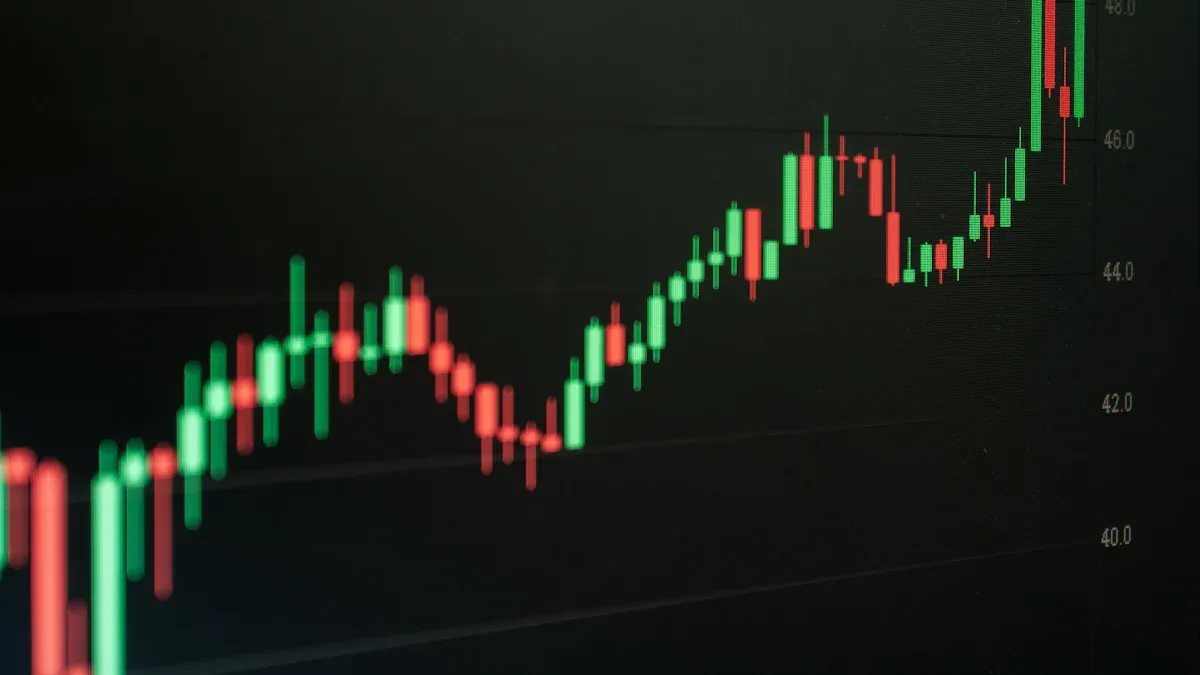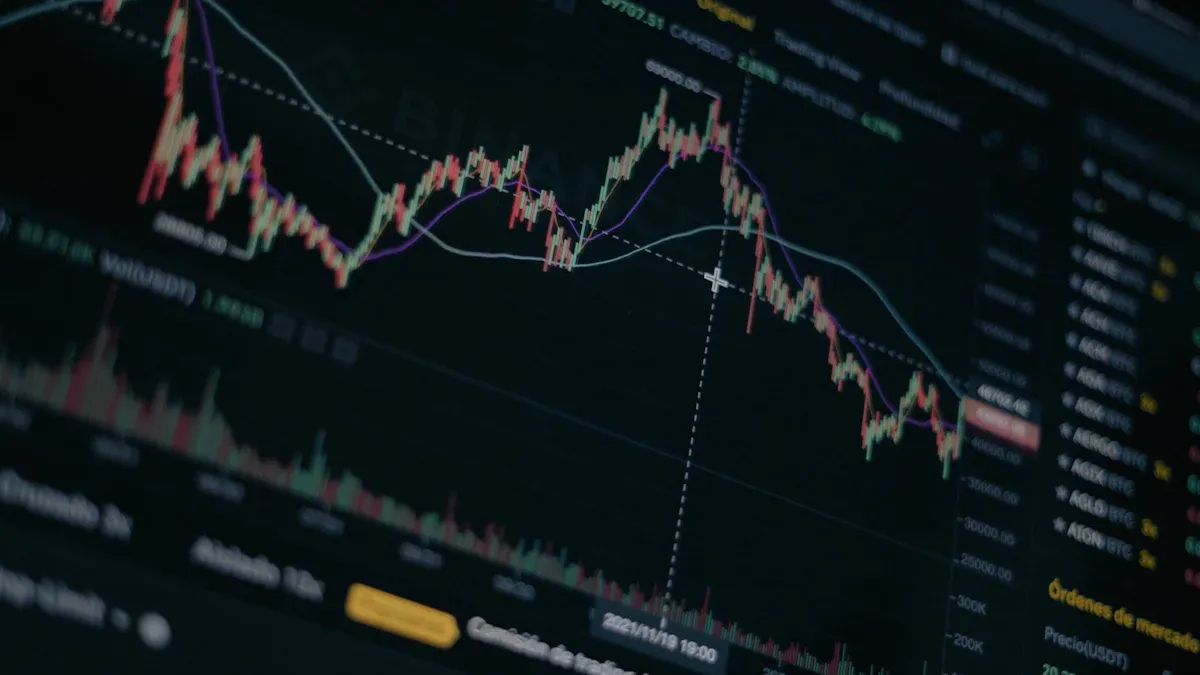- EasyCard
- Trade
- Help
- Announcement
- Academy
- SWIFT Code
- Iban Number
- Referral
- Customer Service
- Blog
- Creator
How to view the relationship between price and volume? Interpreting market signals from seven typical trends

Image Source: unsplash
The price-volume relationship is a powerful tool in market analysis. Research shows a positive correlation between trading volume and implied volatility, especially in extreme market conditions. The table below summarizes key findings:
| Key Finding | Description |
|---|---|
| Positive Correlation | Concurrent and lagged trading volume correlates positively with implied volatility, influenced by availability and conservatism biases. |
| Nonlinear Relationship | The relationship is more pronounced in high distributions, indicating asymmetry. |
| Extreme Conditions | The volume-volatility link is stronger in extreme distributions. |
By analyzing price and volume changes, investors can gauge trend strength. For instance, rising prices with surging volume often confirm an uptrend. The seven typical patterns below help investors efficiently identify market signals and trading opportunities.
Key Highlights
- The price-volume relationship is a critical tool for assessing market trend strength through price and volume dynamics.
- High trading volume signals strong market conviction; rising prices with high volume confirm uptrends.
- Volume spikes during price breakouts indicate reliable trends when above average.
- Combine technical indicators like MACD and RSI to assess price momentum and avoid false breakouts.
- Use price-volume analysis rationally with other indicators to enhance prediction accuracy and trading decisions.
Understanding Price-Volume Relationships

Image Source: pexels
Bullish vs. Bearish Forces and Trends
The price-volume relationship is central to market analysis, revealing the balance between buyers and sellers. High volume reflects strong conviction, while low volume suggests hesitation or limited institutional involvement. The table below outlines typical volume-price dynamics:
| Evidence Type | Description |
|---|---|
| Volume as Belief Measure | High volume indicates strong conviction behind price moves; low volume suggests indecision. |
| Dynamic Relationship | Rising prices with increasing volume signal sustainable moves; rising prices with declining volume hint at weakening momentum and potential reversals. |
| Buying Volume Traits | Aggressive buying shows strong bullish conviction. |
| Selling Volume Traits | Aggressive selling indicates strong bearish conviction. |
Historical data shows that rising prices with expanding volume reflect bullish sentiment, while falling prices with high volume signal bearish dominance. These signals help investors assess trend strength.
Identifying Market Signals
Understanding price-volume dynamics aids in timely signal identification and decision optimization. Research confirms a significant causal link between absolute price changes and volume, particularly during earnings releases. Information arrives sequentially, and market reactions unfold in phases.
- Historical volume data reveals asset trading activity.
- Price breakouts with above-average volume are more reliable.
- Uptrends with high volume suggest strong investor enthusiasm, potentially driving further gains.
- Low-volume breakouts indicate weak conviction, questioning trend sustainability.
Investors use volume, moving averages, RSI, and MACD to confirm signals. These tools identify trend shifts, momentum changes, and valuation levels. Recent studies show deep learning models excel in multifactor analysis, capturing nonlinear relationships and boosting prediction accuracy. Price-volume analysis thus enhances decision-making precision.
Typical Price-Volume Patterns

Image Source: pexels
Price Up, Volume Up
This pattern signals a strong bullish trend. Rising prices with surging volume indicate dominant buying pressure and robust market conviction.
Common in U.S. stock bull market starts or after major positive news.
To identify:
- Check if volume exceeds the 20-day average during new price highs.
- Use MACD and RSI to confirm sustained momentum.
| Pattern Feature | Market Signal | Considerations |
|---|---|---|
| Rising price, high volume | Bullish dominance, trend likely to continue | Watch for short-term overheating, monitor pullback risks |
Price Up, Volume Down
Rising prices with declining volume suggest weakening buying pressure and investor caution.
Price-volume dynamics indicate unsustainable momentum.
Watch for:
- Potential false breakouts if volume doesn’t support price gains.
- Possible pullbacks if volume fails to recover.
Price Down, Volume Up
Falling prices with high volume signal an accelerating bearish trend, often driven by panic selling. Common in U.S. markets post-negative earnings or economic data.
Consider:
- Price breaks below key support with surging volume confirm bearish trends.
- Use moving averages to assess if the decline persists.
| Pattern Feature | Market Signal | Advice |
|---|---|---|
| Falling price, high volume | Bearish dominance, trend accelerates | Avoid bottom-fishing, wait for stabilization |
Price Down, Volume Down
Falling prices with low volume indicate reduced selling pressure and investor hesitation.
Price-volume dynamics suggest weakening bearish momentum, potentially leading to consolidation.
Focus on:
- Limited downside with low volume, hinting at possible rebounds.
- K-line patterns for stabilization signals.
Price Stable, Volume Up
Stable prices with rising volume suggest active capital flow, possibly signaling institutional accumulation or distribution. Common in U.S. markets around earnings releases.
Strategies:
- Monitor breakout direction for trading opportunities.
- Analyze order book activity to gauge institutional intent.
| Pattern Feature | Market Signal | Considerations |
|---|---|---|
| Stable price, high volume | Accumulation or distribution | Watch for false breakouts, set stop-losses |
Price Stable, Volume Down
Stable prices with low volume reflect market indecision, with neither buyers nor sellers dominant.
Price-volume dynamics indicate an unclear trend, requiring patience.
Actions:
- Watch for volume spikes to signal breakout opportunities.
- Avoid frequent trading in low-volume consolidation.
Volume Surge, Price Stagnation
Volume Surge, Price Up Stagnation: High volume with limited price gains suggests distribution, as sellers cap upward momentum.
Volume Surge, Price Down Stagnation: High volume with limited declines indicates potential accumulation, as buyers absorb selling pressure.
These patterns reflect intense buyer-seller conflicts, often signaling institutional moves.
Consider:
- Volume surge with price stagnation may signal distribution; watch for pullbacks.
- Volume surge with limited declines may indicate accumulation, hinting at rebounds.
| Pattern Type | Market Implication | Advice |
|---|---|---|
| Volume Surge, Price Up Stagnation | Distribution, risk of pullback | Set profit-taking levels, manage risks |
| Volume Surge, Price Down Stagnation | Accumulation, potential rebound | Monitor capital flows, enter cautiously |
These patterns help investors gauge market dynamics and make informed trading decisions.
Analysis Methods
Quick Identification Techniques
In trading, quick identification of price-volume changes is key to seizing opportunities. Volume analysis confirms trends and optimizes decisions. Research shows 75% of profitable trades correlate with above-average volume. Focus on price-volume interplay to spot genuine reversals and avoid false signals.
Key volume-price techniques include:
| Technique | Description |
|---|---|
| VWAP | Volume-weighted average price identifies support/resistance. |
| Volume Flow Indicator | Measures buy/sell volume imbalance for sentiment shifts. |
| Volume Price Trend | Combines price and volume to confirm trends or reversals. |
| Volume Candles | Highlights high-volume candles for significance. |
| Risk Management | Uses price-volume structure to manage risk in key zones. |
Practical steps:
- Monitor volume spikes to confirm breakout strength.
- Analyze volume distribution for support/resistance zones.
- Confirm breakouts with volume or seek high-volume pullback entries.
Case Studies
Case 1: U.S. Bank Stock
A U.S. bank stock showed a price-up, volume-up pattern post-earnings. The price broke prior highs with volume exceeding the 20-day average. Using VWAP, traders identified a support zone, while the Volume Flow Indicator confirmed strong buying pressure. Entering on the breakout led to sustained gains, validating price-volume synergy.
Case 2: Hong Kong Bank Stock
A stock from a licensed Hong Kong bank exhibited price-stable, volume-up behavior during consolidation. On-Balance Volume (OBV) showed steady capital inflows, and the Accumulation/Distribution (A/D) line rose. Traders waited for a breakout, entering post-confirmation, achieving solid returns.
These cases highlight how price-volume analysis, paired with tools like VWAP and OBV, enhances trend identification and trading precision.
Limitations and Considerations
Avoiding Pitfalls
Price-volume analysis, while valuable, has limitations. Studies show no consistent correlation or causality in commodity futures markets, where volume concentrates in contract final stages, reducing price discovery and hedging efficiency. Early-stage low volume hinders risk management.
Common pitfalls:
- Assuming technical analysis is only for experienced traders, ignoring foundational knowledge.
- Believing technical analysis guarantees profits, overlooking market uncertainty.
- Thinking it’s only for short-term trading, missing its mid-to-long-term utility.
- Assuming universal effectiveness across market conditions.
- Underestimating success rates, over-relying on single signals.
Approach price-volume analysis rationally, integrating market context to avoid blind signal-following.
Indicator Synergy
Relying solely on price-volume analysis limits market insight. Analysts recommend combining it with technical indicators for better accuracy. Effective pairings include:
- Trend and Momentum: Moving averages with RSI or MACD to identify trend direction and momentum shifts.
- Volatility and Volume: Bollinger Bands with OBV to assess price ranges and capital flows.
Tailor indicator combinations to trading style and market conditions. Multi-signal validation enhances decision-making stability.
Price-volume analysis offers a scientific basis for trend analysis. The seven patterns enable flexible responses to market shifts. Acknowledge limitations, avoid blind reliance, and pair with tools for precision:
- Combining technical analysis with machine learning boosts stock price prediction accuracy.
- Neural networks outperform traditional methods by 15%.
- These insights guide data-driven decisions for investors.
Integrate multiple tools with practical experience to enhance trading precision and stability.
FAQ
Which markets suit price-volume analysis?
Analysts confirm it applies to stocks, futures, and forex. U.S. markets’ transparent data supports direct application.
How do I validate price-volume signals?
Cross-verify with average volume, price breakouts, and technical indicators. U.S. market breakouts with high volume are reliable.
Is price-volume analysis suitable for beginners?
Beginners can learn trends via price and volume changes. U.S. market data and tools enhance analytical skills.
What are common price-volume analysis pitfalls?
Investors may focus on single signals, ignoring market shifts. Combine indicators to avoid blind reliance.
Can price-volume analysis predict reversals?
It aids trend reversal detection but isn’t foolproof. U.S. market traders should use risk management and multi-factor analysis.
Mastering the seven classic price-volume patterns equips you to decode market signals and sharpen trading decisions, but high cross-border fees, currency volatility, and offshore account complexities can hinder acting on U.S. stock signals, especially during swift breakouts or reversals. Imagine a platform with 0.5% remittance fees, same-day global transfers, and contract limit orders with zero fees, enabling seamless price-volume strategies via one account?
BiyaPay is tailored for technical traders, offering instant fiat-to-digital conversions to act on price-volume signals nimbly. With real-time exchange rate query, monitor USD trends and transfer at optimal moments to cut costs. Covering most regions with instant arrivals, it powers rapid allocations to S&P 500 ETFs (like VOO) or high-volume stocks. Crucially, trade U.S. and Hong Kong markets through a single account, leveraging contract limit orders with zero fees for VWAP or OBV-based limit strategies.
Whether chasing volume-backed rallies or dodging stalled moves, BiyaPay fuels your precision. Sign up now, visit stocks for U.S. prospects—quick setup unlocks cost-effective, data-driven trading. Join global investors and conquer 2025 market swings!
*This article is provided for general information purposes and does not constitute legal, tax or other professional advice from BiyaPay or its subsidiaries and its affiliates, and it is not intended as a substitute for obtaining advice from a financial advisor or any other professional.
We make no representations, warranties or warranties, express or implied, as to the accuracy, completeness or timeliness of the contents of this publication.




Contact Us
Company and Team
BiyaPay Products
Customer Services
is a broker-dealer registered with the U.S. Securities and Exchange Commission (SEC) (No.: 802-127417), member of the Financial Industry Regulatory Authority (FINRA) (CRD: 325027), member of the Securities Investor Protection Corporation (SIPC), and regulated by FINRA and SEC.
registered with the US Financial Crimes Enforcement Network (FinCEN), as a Money Services Business (MSB), registration number: 31000218637349, and regulated by FinCEN.
registered as Financial Service Provider (FSP number: FSP1007221) in New Zealand, and is a member of the Financial Dispute Resolution Scheme, a New Zealand independent dispute resolution service provider.



















